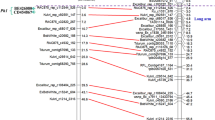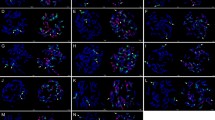Abstract
The distribution of two repetitive DNA probes Sat-121 and PB6-4, specific for the section Procumbentes of the genus Beta, was tested in 16 B. patellaris monosomic addition families using a dot-blot hybridization procedure. All monosomic additions were accurately distinguished from diploid sib plants with both DNA probes. The probe PB6-4, with the strongest signal after hybridization, was selected for rapid screening of an extensive number of putative monosomic additions in B. patellaris or B. procumbens addition families using a squash-blot hybridization procedure. The probe PB6-4 detected 118 monosomic additions in 640 plants (18.4%) in eight different B. procumbens addition families. The addition family with chromosome 4 of B. procumbens was semi-lethal and could not be tested. The distribution of PB6-4 in B. patellaris addition families was confirmed in 63 addition families using the squash-blot procedure. In 4580 plants of these addition families, 628 individual monosomic additions (13.7%) were found. The relationship of the morphological characteristics of monosomic addition plants to the results of the squash-blot hybridization (plants with signal) using probe PB6-4 is quite rigorous but not complete. The correlation between plants with a signal and chromosome number (2n=19) is complete. These results indicate that sequences present on PB6-4 are probably present on all chromosomes of B. patellaris and B. procumbens. The possibility of utilizing the sequence information of Sat-121 for a PCR-based assay to screen for putative monosomic addition plants was also investigated as an alternative to chromosome counting. The DNA-amplification profiles using the primers REP and REP.INV clearly distinguished monosomic addition plants from their diploid sibs.
Similar content being viewed by others
References
Bosemark NO (1969) Interspecific hybridization in Beta L: prospects and value in sugar beet breeding. J Int Inst Sugar Beet Res 4:112–121
Cheung WY, Hubert N, Landry BS (1993) A simple and rapid DNA microextraction method for plant, animal, and insect suitable for RAPD and other PCR analyses. PCR Methods and Applications 3:69–70
Coons GH (1975) Interspecific hybrids between Beta vulgaris L. and the wild species of Beta. J Am Soc Sugar Beet Technol 18:281–306
Feinberg AP, Vogelstein B (1983) A technique for radioactive labeling DNA restriction endonuclease fragments to high specific activity. Anal Biochem 132:6–13
Flavell RB (1982) Recognition and modification of crop plant genotypes using techniques of molecular biology. In: Vasil IK, Scowcroft WR, Frey K (eds) Plant improvement and somatic cell genetics. Academic Press, London New York, pp 277–291
Heijbroek W, Roelands AJ, De Jong JH (1983) Transfer of resistance to beet cyst nematode from Beta patellaris to sugar beet. Euphytica 32:287–298
Heijbroek W, Roelands AJ, De Jong JH, Van Hulst C, Schoone AHL, Munning RG (1988) Sugar beets homozygous for resistance to beet cyst nematode (Heterodera schachtii Schm.), developed from monosomic additions of B. procumbens to B. vulgaris. Euphytica 38:121–131
Hutchinson J, Abbott A, O'Dell M, Flavell RB (1985) A rapid screening technique for the detection of repeated DNA sequences in plant tissues. Theor Appl Genet 69:329–333
Jung C, Wricke G (1987) Selection of diploid nematode-resistant sugar beet from monosomic addition lines. Plant Breed 98:205–214
Jung C, Herrmann RG (1991) A DNA probe for rapid screening of sugar beet (Beta vulgaris L.) carrying extra chromosomes from wild beets of the Procumbentes section. Plant Breed 107:275–279
Lange W, Jung Chr, Heijbroek W (1990) Transfer of beet cyst nematode resistance from Beta species of the section Patellares to cultivated beet. Proc 53rd th Winter Congr Intern Inst Sugar Beet Res, Brussels, pp 89–102
Lange W, De Bock Th SM, Van Geyt JPC, Oléo M (1988) Monosomic additions in beet (Beta vulgaris) carrying extra chromosomes of B.procumbens. II. Effects of the alien chromosomes on in vivo and in vitro plant development. Theor Appl Genet 76:656–664
Löptien H (1984) Breeding nematode-resistant beets. II. Investigations into the inheritance of resistance to Heterodera schachtii schm. in wild species of the section Patellares. Z Pflanzenzüchtg 93:237–245
Nakamura C, Skaracis GN, Romagosa I (1991) Cytogenetics and breeding in sugar beet. In: Tsuchiya T, Gupta PK (eds) Chromosome engineering in plants: genetics, breeding, evolution. Part B. Elsevier, Amsterdam, pp 295–313
Reamon-Ramos SM, Wricke G (1992) A full set of monosomic addition lines in Beta vulgaris from Beta webbiana: morphology and isozyme markers. Theor Appl Genet 84:411–418
Salentijn EMJ, Sandal NN, Lange W, De Bock Th SM, Krens FA, Marcker KA, and Stiekema WJ (1992) Isolation of DNA markers linked to a beet cyst nematode resistance locus in Beta patellaris and Beta procumbens. Mol Gen Genet 235:432–440
Salentijn EMJ, Sandal NN, Klein-Lankhorst R, Lange W, De Bock Th SM, Marcker KA, Stiekema WJ (1994) Long-range organization of a satellite DNA family flanking the beet cyst nematode resistance locus Hs1 on chromosome-1 of B. patellaris and B. procumbens. Theor Appl Genet 89:459–466
Savitsky H (1975) Hybridization between Beta vulgaris and Beta procumbens and transmission of nematode (Heterodera schachtii) resistance to sugar beet. Can J Genet Cytol 17:197–209
Savitsky H (1978) Nematode (Heterodera schachtii) resistance and meiosis in diploid plants from interspecific Beta vulgaris x B. procumbens hybrids. Can J Genet Cytol 20:177–186
Schmidt T, Heslop-Harrison JS (1993). Variability and evolution of highly repeated DNA sequences in the genus Beta. Genome, 36:1074–1079
Schmidt T, Metzlaff M (1991) Cloning and characterization of a Beta vulgaris satellite DNA family. Gene 101:247–250
Schmidt T, Junghans H, Metzlaff M (1990) Construction of Beta procumbens-spscific DNA probes and their application for the screening of B. vulgaris x B. procumbens (2n=19) addition lines. Theor Appl Genet 79:177–181
Schmidt T, Jung C, Metzlaff M (1991) Distribution and evolution of two satellite DNAs in the genus Beta. Theor Appl Genet 82:793–799
Schmidt T, Boblenz K, Metzlaff M, Kaemmer D, Weising K, Kahl G (1993) DNA fingerprinting in sugar beet (Beta vulgaris) -identification of double-haploid breeding lines. Theor Appl Genet 85:653–657
Speckmann GJ, De Bock Th SM (1982) The production of alien monosomic additions in Beta vulgaris as a source for the introgression of resistance to beet root nematode (Heterodera schachtii) from Beta species of the section Patellares. Euphytica 31:313–323
Speckmann GJ, De Bock Th SM, De Jong JH (1985) Monosomic additions with resistance to beet cyst nematode obtained from hybrids of Beta vulgaris and wild Beta species of the section Patellares. Z Pflanzenzüchtg 95:74–83
Van der Beek JG, Verkerk R, Zabel P, Lindhout P (1992) Mapping strategy for resistance genes in tomato based on RFLPs between cultivars: Cf9 (resistance to Cladosporium fulvum) on chromosome 1. Theor Appl Genet 84:106–112
Van Geyt JPC, Oléo M, Lange W, De Bock Th SM (1988) Monosomic additions in beet (Beta vulgaris) carrying extra chromosomes of Beta procumbens. I. Identification of the alien chromosomes with the help of isozyme markers. Theor Appl Genet 76:577–586
Van Geyt JPC, Lange W, Oléo M, De Bock Th SM (1990) Natural variation within the genus Beta and its possible use for breeding sugar beet: a review. Euphytica 49:57–76
Author information
Authors and Affiliations
Additional information
Communicated by M. Koornneef
Rights and permissions
About this article
Cite this article
Mesbah, M., De Bock, T.S.M., Sandbrink, J.M. et al. Selection of monosomic addition plants in offspring families using repetitive DNA probes in Beta L.. Theoret. Appl. Genetics 92, 891–897 (1996). https://doi.org/10.1007/BF00221903
Received:
Accepted:
Issue Date:
DOI: https://doi.org/10.1007/BF00221903




